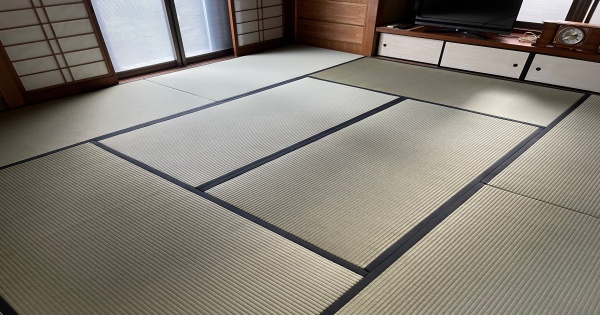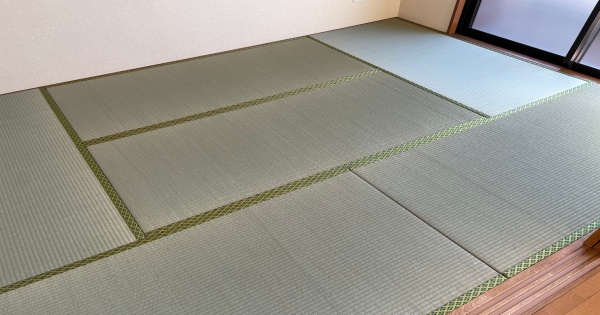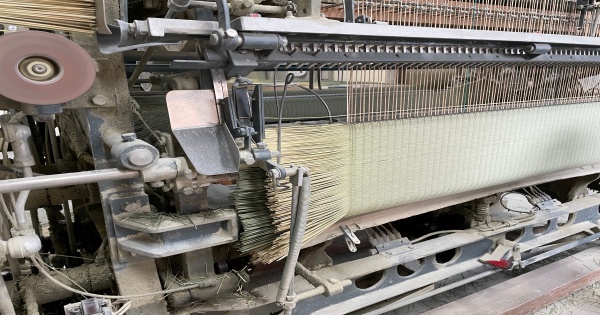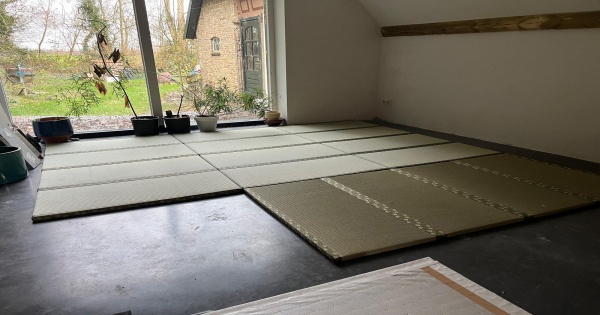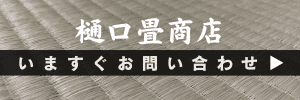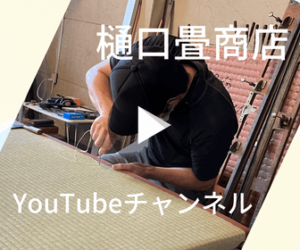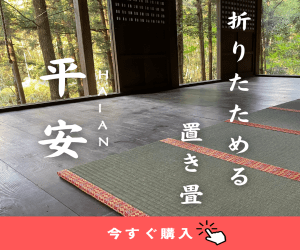
Nice to meet you. My name is Yusuke Higuchi, and I run a tatami shop in Edogawa, Tokyo, called Higuchi Tatami Shop. This article is an introduction to me, Yusuke Higuchi. I will share why I became a tatami craftsman, how I became one, and the process of starting Higuchi Tatami Shop.
The Reason I Became a Tatami Craftsman

The reason I became a tatami craftsman? Well… there isn't really one.
Sure, I admired my grandfather, who was a tatami craftsman. But looking back now, I'm not sure if that’s the real reason I chose this path.
I didn't have anything I really wanted to do. I had no dreams or goals. The only thing that interested me was making things, especially sewing.
I've always been good at sewing. In home economics class, I was the fastest and neatest at sewing buttons, and when my baseball uniform got torn, I could sew on the knee patches faster and better than my mom, even as an elementary school student. Sewing was fun for me. When I was sewing, I could focus with the same intensity as when I was reading a book or playing video games, completely absorbed in the task.
That said, I didn’t think I had much talent for design, so I figured sewing could just be a hobby.
How I Became a Tatami Craftsman

During summer vacation in high school, we had career counseling. When I told my counselor that I didn't want to go to university, they gave me a stack of recruitment flyers from companies looking to hire high school graduates.
At the time, none of the companies seemed appealing to me. It wasn’t that the salaries or working conditions looked bad; I just didn't find any of the jobs interesting.
As I was struggling with what to do, my counselor suggested that I look into the jobs my parents or relatives were doing for inspiration.
At that moment, the first thing that came to mind was tatami craftsmanship.
I thought it might be cool to become a craftsman like my grandfather, who I admired so much. I wanted to try making tatami. I think that's what sparked my decision to become a tatami craftsman.
How Do You Become a Tatami Craftsman?
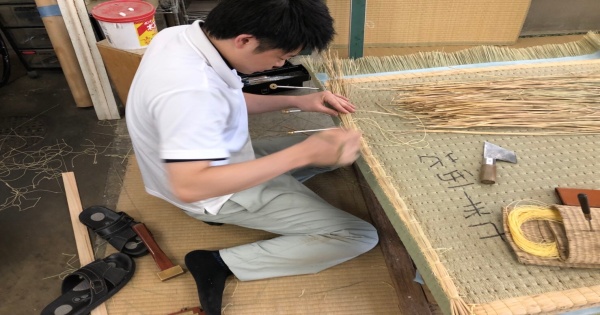
How do you become a tatami craftsman? According to the information my high school teacher found, there were two ways. One was to look for companies hiring tatami craftsmen through the public employment service (Hello Work), and the other was to attend a school specialized in tatami-making.
After discussing it with my teacher, I decided to attend a tatami school. I then began researching what this "tatami school" was all about.
Tatami schools are institutions established to ensure the traditional skills and knowledge of tatami craftsmanship are passed down to future generations. The instructors are professionals in the field. Some, like the head of the company where I trained, have been awarded the prestigious Medal with Yellow Ribbon, or have been recognized as Contemporary Master Craftsmen.
These tatami schools can be found in Saitama, Ibaraki, Fukuoka, and Kyoto. Among them, Kyoto is a particularly popular choice for students from all over Japan. You could call it the "Kyoto brand." I was also drawn to this, and that’s why I decided to enroll in the Kyoto Tatami Craftsmanship Academy.
My Days as a Tatami Apprentice in Kyoto
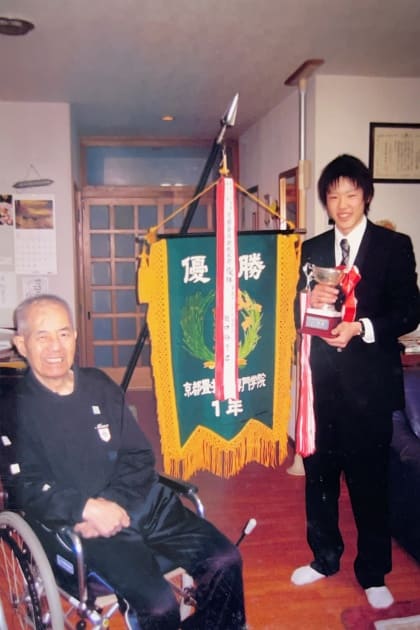
What did I do during my six years in Kyoto? Grueling training, days full of sweat and tears—it was a tough six years.
Or so you might think, but that’s not true at all! Once work was over, it was off to drinking parties. After school, more drinking parties. Saturdays? We’d drink and hang out until morning. Honestly, I never really felt like my tatami training was hard, painful, or difficult. I think I was just lucky. Thanks to the amazing people I met, like the staff at Sawabe Tatami Shop, my classmates, seniors, juniors, and my teachers—Nishiwaki-sensei, Kimura-sensei, Okuda-sensei, Fujimoto-sensei, and Iii-sensei—along with the friends I met at Rakuen, I didn’t find anything difficult at all. In fact, it was a lot of fun.
I think the reason I was able to stick with tatami craftsmanship for six years was because of the wonderful people I met in Kyoto. I’m truly grateful to all of them.
Would It Have Been Okay to Quit Being a Tatami Craftsman?

To be honest, if I didn’t find being a tatami craftsman interesting, I was ready to quit and return to Tokyo right away.
I didn’t have any burning passion like, “I’m going to make a living with tatami! I’ll become a craftsman for life!” Instead, I had a more laid-back attitude, just hoping it might be fun.
I still remember the first time I held a tatami needle and tried to sew. It was hard, painful, and intimidating. I was surprised that people could actually sew like this. But as I gradually learned the work, did it more and more, and gained experience, I began to be trusted with new tasks, and I could feel myself steadily improving.
Creating things is fun. Maybe it’s because I could feel my own growth and see the smiles on customers’ faces. When you put sincerity into craftsmanship, the results always come back.
The more strict I was with myself, the more the customers appreciated it. Seeing them smile made me happy too. What started as personal satisfaction with my skills became something rewarding. That’s how it felt.
I thought I’d quit being a tatami craftsman if I didn’t enjoy it. But before I knew it, that thought disappeared, and I became absorbed in the tatami work right in front of me.
“Passion doesn’t come first; it follows after.”
I can’t remember who said that, but I really believe it’s true.
What I started with the mindset of “I can always quit if it’s not fun” turned into something I wanted to become better at because the work was interesting. I wanted to make customers happy, and the passion naturally followed. Maybe, instead of overthinking things, it’s much more efficient for someone like me to learn by doing.
In any case, I feel incredibly fortunate to have found work I truly enjoyed while still in my teens.
What I Learned in Kyoto

What I learned in Kyoto can be broadly divided into two main points. The first is that tatami craftsmanship involves techniques used in areas that are not visible. Once tatami mats are installed, you cannot see the areas where the work was done. It’s possible to cut corners and do a poor job if one wanted to.
Recently, I’ve heard that some contractors use tacks to secure tatami mats. Japan has a high amount of rainfall and is surrounded by sea and mountains, which makes it a country with a humid climate. Over time, the tacks used in such a humid environment can rust and become loose.
While tack-based installation might be acceptable for short-term use, the best method for ensuring long-term durability is to use thread to secure the tatami mats.
In other words, what’s crucial in tatami work is understanding how to perform the installation to ensure the mats last for a long time and how to apply craftsmanship to areas not visible to the customer. I learned the importance of not being careless simply because the work isn’t visible to the customer.
The Second Thing I Learned: The Space of a Traditional Japanese Room
The second thing I learned is about the space of a traditional Japanese room. In Kyoto, old-style Japanese houses line the streets. Especially within the city of Kyoto, there are many long, narrow houses known as machiya, and I have taken on numerous tatami replacement projects in these homes.
Dim lighting, artistic earthen walls, fusuma doors made of washi paper, shoji screens that gently filter sunlight, impressive tokonoma alcoves, and courtyards—all these elements have cultural value and harmoniously create the space.
It was in Kyoto that I first understood how the blend of natural and artificial elements can be something truly cherished. I encourage everyone, if you visit Kyoto, to take a moment to appreciate and explore the spaces created by the Japanese of the past.
A Side Note.Kyoto is not just thoughtfully designed inside its homes; the city itself is also meticulously planned. Whether it’s Hanami-koji Street, Miyagawa-cho, Kamishichiken, or Ishihara-koji, the cityscape of Kyoto has a way of influencing and immersing you in the space of Kyoto.
Kyoto’s carpenters didn’t just build houses; they designed the space with consideration for the climate, landscape, and cityscape before constructing the homes. I truly admire Kyoto’s carpenters for their exceptional work. If you visit Kyoto, I hope you take the time to enjoy these thoughtfully designed views as well.
About the Kyoto Tatami Competition
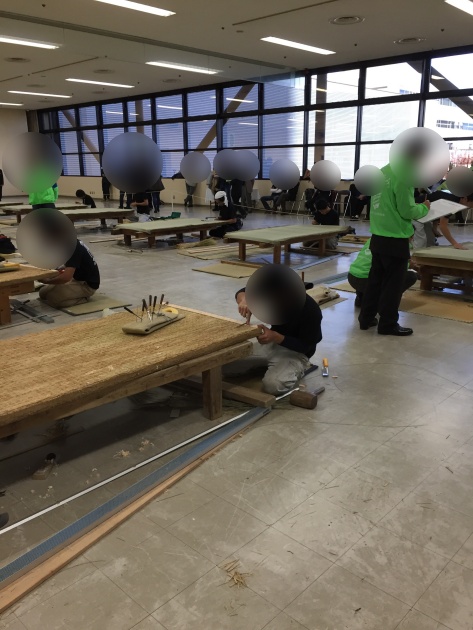
In Kyoto, the Kyoto Tatami Competition is held once a year at Kyoto Pulse Plaza. This competition brings together young craftsmen (academy students) who compete based on prescribed construction procedures, time limits, dimensions, and overall quality. Although the competition is officially an individual event meant to assess and rank individual skills, in reality, it has become a battle that reflects the prestige of the participating shops.
Winning the Kyoto Tatami Competition serves as proof of the high technical level of the shop where the competitor trained. It might sound grand to say it’s a way of repaying the shop for its support, but many academy students approach the competition with this kind of spirit.
I was fortunate to win the Kyoto Prefectural Governor's Award for four consecutive years: 2011, 2012, 2013, and 2014. (Although, I have to admit, the results in the years other than 2014 were not as satisfying.)
The difficulty of the Kyoto Tatami Competition lies in achieving high quality and precise dimensions within a strict time limit. Rushing due to the tight schedule often results in rough stitching and slight dimensional inaccuracies.
However, with each year of participation, I became more familiar with my own tendencies, which I believe helped in the 2014 competition. Winning the competition was a great achievement, and I feel it allowed me to give back to the shop, even if just a little.
Completing My Tatami Training in Kyoto
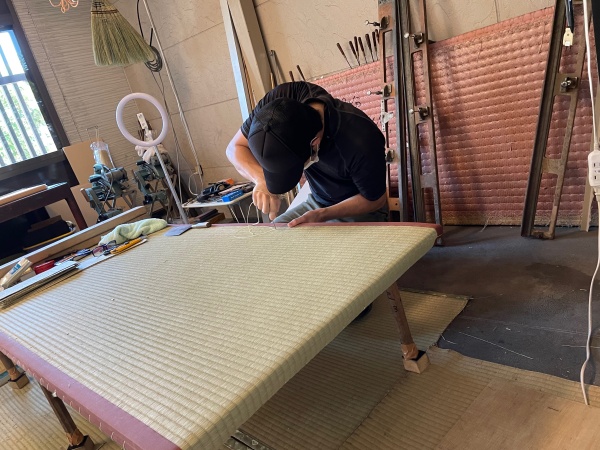
My tatami training period lasted about four years, concluding in April 2015, at which point I began working as a full-fledged craftsman. With two years remaining (until April 2017), I prepared to graduate from Sawabe Tatami Shop, where I had been training.
This phase was different from my training period; I had to consider my future path, whether to continue as a craftsman or to open my own tatami shop among many other options.
Upon returning to Tokyo, I decided to aim for a freelance tatami craftsman role, seeking work from local tatami shops and acquaintances. I initially focused on reaching out and requesting jobs.
However, reality proved challenging. Subcontracted work was often busy but not financially rewarding. There were times when I considered quitting the tatami profession.
A turning point came during the COVID-19 pandemic. I heard that many tatami shops in Edogawa Ward were closing. I saw this as an opportunity—starting during a time when many were leaving the industry would generate interest and make it easier to capture market share.
So, I reached out to acquaintances in Kyoto to acquire tatami tools and equipment, and on November 1, 2020, I opened Higuchi Tatami Shop.
Profile of Yusuke Higuchi, Founder of Higuchi Tatami Shop
That concludes the profile of Yusuke Higuchi, founder of Higuchi Tatami Shop. Despite the many challenges, I have grown to the point where I now deliver tatami mats internationally. I look forward to expanding further into international markets and welcome any inquiries you may have.
For inquiries, please contact us here:https://phkkoomde.com/profile/contact/
